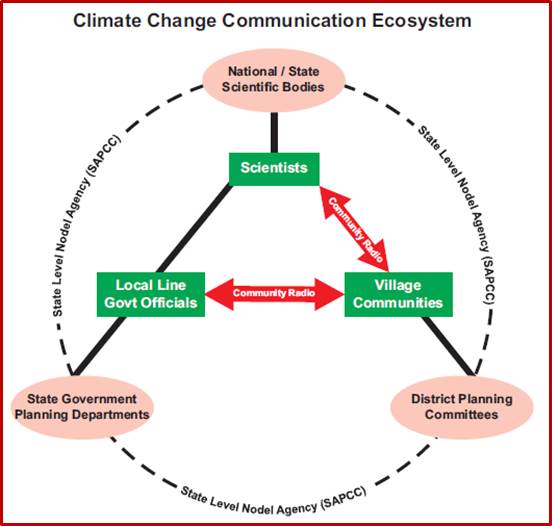|
Communicating
Climate Change Effectiveness of Community Radios C ommunity radio stations are a significant medium for disseminating information about agriculture, health, education, women’s issues, livelihoods and climate change to the most vulnerable and indigenous communities. In remote rural areas, community radio is often the only medium available, which is listened to by large parts of the population. This medium has also proved to become the most accessible and trustworthy information medium in disaster hit regions of the world. In Nepal last year when the 7.8 magnitude earthquake came, many radio stations were adversely affected. But despite the damaged premises and equipment, these community radios started operating from tents in just a few hours and began disseminating crucial information to the local communities. Radio became the source of life saving information where newspapers or television or internet service were not available. Similarly in India, when the disasters in Kedarnath, Uttarakhand and Tamilnadu took place, community radios played a crucial role in informing and sensitising the local communities.Development Alternatives as a Pioneer of Climate Change Communication in India When it comes to climate change communication,
community radios lack u Development Alternatives has taken the lead to successfully implement a climate change communication campaign in India, by the name of Shubh Kal (for a better tomorrow). This campaign was started in 2008 with one community radio in Bundelkhand, one of India’s most climate sensitive regions in Central India when Development Alternatives launched India’s first climate rural reality show by the name of Kaun Banega Shubhkal Leader on Radio Bundelkhand. Climate champions from local villages were selected and trained in various adaptation practices. Prakash Kushwaha, a 25 year old farmer from Rajawar village in the Tikamgarh district learnt about Amrit Mitti (an organic fertiliser) during the show. Through the course of the competition, the Amrit Mitti revolution spread across Rajawar and all the surrounding villages. Almost 200 farmers switched to using organic manure replacing the use of chemical fertilisers in their fields. Prakash’s story has emerged as one of the most impactful climate change adaptation case studies at the grassroots. He was one of the final winners of the show. A few years later, the Shubh Kal campaign was
expanded to disseminate climate information to more than 6,00,000 rural
folk in 400 villages when Development Alternatives’ Radio Bundelkhand
tied up with three other community radios in the Bundelkhand region
namely Lalit Lokwani, Radio Dhadkan and Chanderi Ki Awaaz. 35 community
radio reporters were trained in climate change journalism to serve as an
effectiv Recent Developments Development Alternatives’ experience of climate change communication with community radios has completed 8 years. The Shubh Kal campaign has recently been rolled out for larger dissemination in India. The Development Alternatives team has built the capacity of 29 community radios from the states of Assam, Bihar, Chhattisgarh, Kerala, Maharashtra and Odisha to create awareness on climate change. Each of the community radios have developed and broadcasted 4 programmes each on climate change as per the local needs of their community. The Shubh Kal campaign has reached approximately 3 million people with the help of 29 community radios. People who listened to these programmes found that the information was relevant in their context and needed more such information through community radios. Conclusion Climate change communication is relatively a new concept for community radios in India. The lack of locally relevant resource material for grass root communities to understand climate change and its impacts is a major challenge. Hence, community radios require more capacity building modules and handholding on climate change issues for regular broadcasting and information flow. q Desh Raj Singh Naheda Shaikh
|
 nderstanding
of the science, impact and adaptation mechanisms of climate change.
Enhancing the capacity of community radios on climate change
communication can play an important role in creating awareness among the
communities for building their resilience to the impacts of climate
change.
nderstanding
of the science, impact and adaptation mechanisms of climate change.
Enhancing the capacity of community radios on climate change
communication can play an important role in creating awareness among the
communities for building their resilience to the impacts of climate
change. e
two way communication link between farmers, government line department
officials and scientific experts from agriculture extension agencies
such as Krishi Vigyan Kendras (KVKs). These radio reporters
addressed concerns of the farming community by bringing their queries
and concerns to the scientists and line department government officials
and disseminated information from the scientists and the government
officials on adaptation options and relevant government schemes to the
farming community.
e
two way communication link between farmers, government line department
officials and scientific experts from agriculture extension agencies
such as Krishi Vigyan Kendras (KVKs). These radio reporters
addressed concerns of the farming community by bringing their queries
and concerns to the scientists and line department government officials
and disseminated information from the scientists and the government
officials on adaptation options and relevant government schemes to the
farming community.